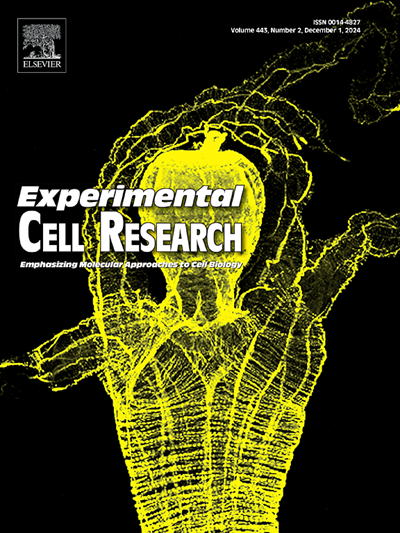The phosphorylation of moesin impairs the integrity of vascular basement membrane in pathological angiogenesis
IF 3.5
3区 生物学
Q3 CELL BIOLOGY
引用次数: 0
Abstract
Our previous studies demonstrated that advanced glycation end products (AGEs) promote angiogenesis in human umbilical vein endothelial cells (HUVECs) and mouse retina through moesin phosphorylation. AGEs-induced angiogenesis is characterized by abnormal VE-cadherin distribution at adherens junctions and decreased pericytes coverage. In this study, we further investigated the alterations in collagen IV (Col-IV) distribution within the basement membrane (BM) of neovesssles using a HUVECs-retinal microvascular pericytes (RMPs) co-culture system and an AGEs-treated mouse model. The role of moesin phosphorylation in AGEs-induced BM abnormalities was explored through phosphorylation modulation. The results confirmed that AGEs-induced immature angiogenesis in HUVECs-RMPs co-culture system, characterized by decreased pericyte coverage and uneven Col-IV distribution in the neovessel BM. Similar results were observed in retinal vessels from AGEs-treated mice. Modulation of moesin phosphorylation altered the AGEs-induced maldistribution of Col-IV in the vascular BM. We observed obvious co-localization of phosphorylated moesin with heterogenous adhesion molecule CD44 in mouse retinal vessels. This study demonstrates that AGEs induce abnormal distribution of Col-IV in the vascular BM and subsequent neovessel immaturity via phosphorylation of moesin and disruption of heterogenous adhesion junction formation.
在病理性血管生成中,moesin的磷酸化损害了血管基底膜的完整性
我们之前的研究表明,晚期糖基化终产物(AGEs)通过moesin磷酸化促进人脐静脉内皮细胞(HUVECs)和小鼠视网膜的血管生成。age诱导的血管生成的特征是粘附连接处ve -钙粘蛋白分布异常和周细胞覆盖减少。在这项研究中,我们使用huvec -视网膜微血管周细胞(RMPs)共培养系统和age处理的小鼠模型进一步研究了IV型胶原(Col-IV)在新生血管基底膜(BM)内分布的变化。通过磷酸化调节探讨moesin磷酸化在ages诱导的BM异常中的作用。结果证实,在HUVECs-RMPs共培养系统中,age诱导未成熟血管生成,其特征是周细胞覆盖率下降,新生血管BM中Col-IV分布不均匀。在经ages处理的小鼠的视网膜血管中也观察到类似的结果。调节moesin磷酸化改变了ages诱导的血管BM中Col-IV的异常分布。我们在小鼠视网膜血管中观察到磷酸化moesin与异质粘附分子CD44的明显共定位。该研究表明,AGEs通过磷酸化moesin和破坏异质粘附连接形成,诱导血管BM中Col-IV的异常分布和随后的新血管不成熟。
本文章由计算机程序翻译,如有差异,请以英文原文为准。
求助全文
约1分钟内获得全文
求助全文
来源期刊

Experimental cell research
医学-细胞生物学
CiteScore
7.20
自引率
0.00%
发文量
295
审稿时长
30 days
期刊介绍:
Our scope includes but is not limited to areas such as: Chromosome biology; Chromatin and epigenetics; DNA repair; Gene regulation; Nuclear import-export; RNA processing; Non-coding RNAs; Organelle biology; The cytoskeleton; Intracellular trafficking; Cell-cell and cell-matrix interactions; Cell motility and migration; Cell proliferation; Cellular differentiation; Signal transduction; Programmed cell death.
 求助内容:
求助内容: 应助结果提醒方式:
应助结果提醒方式:


